925-838-9225
For information on mountain weather conditions
Operating Hours
Gates open 8:00am and close at sunset. Visitors should plan to be in their vehicles by sunset and headed out to avoid being locked in.
The Visitor Center will be open 7 days a week from 10 am to 4 pm.
Summit Museum is open:
Open 7 days a week 10 am to 4 pm.
Mitchell Canyon Interpretive Center is open Weekends only and some holidays.
Summer Hours
8:00am to 4:00pm
Winter Hours
10:00am to 2:00pm
Mailing Address
Mount Diablo State Park
96 Mitchell Canyon Road
Clayton, CA 94517
Additional thanks go to Ken Lavin of The Mount Diablo Interpretive Association, Dr. Carol Tang and Dr. Peter Roopnarine of the California Academy of Sciences, and Judy Scotchmoor of the UC Berkeley Natural History Museums for their contributions to this piece.
Mt. Diablo: an upside-down trek through time
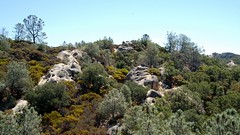 Mt. Diablo can be an intimidating place for a geologist. It's an almost inexplicable scrunch of mixed up, twisted rock layers piled on each other in what looks to be backward chronological order. Combine that with the fact that a hike on Mt. Diablo could involve encounters with rattlesnakes, tarantulas, and other unpleasant critters, and it's easy to see why many rock studiers once left this mysterious mountain to the biologists.
Mt. Diablo can be an intimidating place for a geologist. It's an almost inexplicable scrunch of mixed up, twisted rock layers piled on each other in what looks to be backward chronological order. Combine that with the fact that a hike on Mt. Diablo could involve encounters with rattlesnakes, tarantulas, and other unpleasant critters, and it's easy to see why many rock studiers once left this mysterious mountain to the biologists.
Scientists visiting Mt. Diablo in the 1800s found not only abundant plant and animal life, they also discovered evidence of the region's rich biological past. Fossils lodged in rocks gave away the area's past lives as an ocean floor and a stream-filled flatland. When the science of plate tectonics-- the notion that the earth's crust is composed of many large, mobile plates whose movements cause earthquakes, mountains, and other geological phenomena-- came into acceptance in the 1970s, it brought ways to explain the presence and order of the mountain's confusing rock layers. Soon geologists and paleontologists joined the biologists, developing a picture of whats taken place in Mt. Diablo's neighborhood over the last 200 million years.
Looming over the landscape near Walnut Creek, Mt. Diablo is a paradox: it has some of the oldest rocks in the Bay Area, yet it's one of the region's youngest geological features, having risen at most only about 2 million years ago (by mountain standards, that makes it a real whipper-snapper). And even though it looks for all the world like a volcano, it isn't one.
The ground's all turned around
If you were to clean out an old trunk that you'd been steadily tossing things into for years, you'd probably notice a pattern: the items at the bottom of the trunk would be the oldest ones, left there years before the things sitting at the top. The same is true for layers of rock... usually. Mt. Diablo is just the opposite: the oldest rock is found at the summit of the mountain, and the newest rock at the bottom.
How can this be? Geologists are still stumped about some aspects of the mountain's formation. What they believe is that Diablo was once a slab of ocean floor that was pushed up and folded by the forces of plates moving past each other. This folding drove the oldest tiers toward the top. If you could cut Mt. Diablo in half and look at these layers from the side, it would resemble a sandwich standing on end. The oldest rocks would be the filling, flanked by a younger layer of rock on each side, flanked again on each side by an even younger layer, and so on.
Layered stories of times past
Mt. Diablo's many rock layers offer clues to conditions in the area over the last 200 million years. A complete tour of the mountain's history would fill a hefty tome, but here are a few highlights:
190 – 90 million years ago: An ancient ocean floor
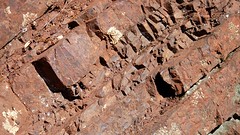 The park's oldest rocks, dating between 190 to 90 million years ago, make up the mountain's summit. A collection called the Franciscan Complex, they are evidence of a collision between plates on the ocean floor. In such an area, known as a subduction zone, one plate slides under another. Greenstone found on Mt. Diablo was scraped from the top of the submerging plate as it dove under its neighbor. Another Franciscan rock, chert, is made of the fossil skeletons of tiny sea creatures whose bodies formed thick layers on the ocean floor.
The park's oldest rocks, dating between 190 to 90 million years ago, make up the mountain's summit. A collection called the Franciscan Complex, they are evidence of a collision between plates on the ocean floor. In such an area, known as a subduction zone, one plate slides under another. Greenstone found on Mt. Diablo was scraped from the top of the submerging plate as it dove under its neighbor. Another Franciscan rock, chert, is made of the fossil skeletons of tiny sea creatures whose bodies formed thick layers on the ocean floor.
50 million years ago: A prehistoric sea basin filling with sediment
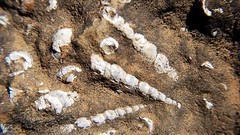 Over time, plate movements in the Mt. Diablo region created a shallow basin that filled with water to make an inland sea, producing shorelines and swampy backwaters. In the warming global climate, sub-tropical plants and animals thrived. The fossils of some sea creatures are easy to find along trails in the park, preserved in rocks formed by sediments piling into the ancient sea. The bodies of others collected in the swamps as peat, which compressed over time into a low-grade coal that was mined and shipped to San Francisco in the later half of the 1800s.
Over time, plate movements in the Mt. Diablo region created a shallow basin that filled with water to make an inland sea, producing shorelines and swampy backwaters. In the warming global climate, sub-tropical plants and animals thrived. The fossils of some sea creatures are easy to find along trails in the park, preserved in rocks formed by sediments piling into the ancient sea. The bodies of others collected in the swamps as peat, which compressed over time into a low-grade coal that was mined and shipped to San Francisco in the later half of the 1800s.
20-10 million years ago: The ground shifts, the sea recedes
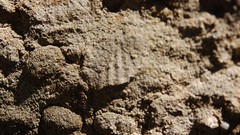 During this time, the movement of the plates around Mt. Diablo shifted. Rather than one diving under the other, they began to move against each other horizontally. Even today this is still the direction of movement in the region, and is what gives rise to earthquakes along the San Andreas and other nearby faults. This new direction of movement made changes to the landscape that caused the water to drain from the inland sea, leaving behind a coastal plain. Sea creatures trapped in mud at this time were destined to become fossils, and you can spot the occasional scallop or oyster from this period in the stones used to build campsite stoves in Mt. Diablo State Park.
During this time, the movement of the plates around Mt. Diablo shifted. Rather than one diving under the other, they began to move against each other horizontally. Even today this is still the direction of movement in the region, and is what gives rise to earthquakes along the San Andreas and other nearby faults. This new direction of movement made changes to the landscape that caused the water to drain from the inland sea, leaving behind a coastal plain. Sea creatures trapped in mud at this time were destined to become fossils, and you can spot the occasional scallop or oyster from this period in the stones used to build campsite stoves in Mt. Diablo State Park.
7-10 million years ago: Mammals rule the flatlands
The sea came and went once more, leaving the area dry one last time. Rivers then flowed through the sea-less basin, making it inviting for a wide variety of land mammals, large and small. Stream deposits on the land that became the mountain's south side gave rise to one of the richest fossil beds in the United States (second only to the LaBrea Tar Pits in southern California). Paleontologists working at Mt. Dialblo have unearthed fossils of horses, rhinos, camels, and even a mastodon skull, among many other finds.
2 million years ago: At last, the landscape rises
The earth that makes up Mt. Diablo began to creep upward at this time, but scientists haven't been able to determine exactly why. Two theories exist: one posits that there was a thrust fault (a fault in which one plate has moved under another, pushing the top plate up) near the surface of the earth where the mountain now stands. As the bottom plate moved under, it bent the edge of the top plate, lifting and folding it, creating the mountain. A second theory suggests that plates around the area of the mountain were moving horizontally relative to each other, and that a thrust fault far below the surface (called a blind fault) pushed the mountain up.
Whether or not Mt. Diablo was formed by a blind thrust fault, many researchers believe such a fault exists under the mountain today, pushing it steadily upward. At 3,849 feet, Mt. Diablo continues to rise a few millimeters a year, and its landscape is still changing. The mountain's unique geology and the extraordinary number of fossil species found there-- 455-- draws scientists from many disciplines. Slowly they are adding pages to the story of this ever-changing place.
The Mount Diablo Interpretive Association
The Mount Diablo Interpretive Association are well-regarded stewards of the park, with a dedicated volunteer corps and regular docent-led hikes. Coming up soon:
Tarantula Trek
Sunday September 30 & Saturday October 6, 3PM
A 19th century visitor to Mount Diablo described the tarantula as "attaining the size of a small bird, possessing fangs the size of a rattlesnakes', and delivering a bite generally considered fatal" Fact or fiction? Join us for a tarantula talk, followed by a nature hike to search for Mount Diablo's giant spiders.
Meet at the Mitchell Canyon Visitor Center in Mount Diablo State Park for this easy hike. Back by 6 PM. $3 parking fee. Hike led by Ken Lavin. Contact: (925)686-9393 , ken_lavin@hotmail.com.
Trek Through Time: East Bay - Greenbelt Outing
Saturday December 1 10:30am - 4pm
Join the Greenbelt Alliance for a walk through 150 million years of geologic history on Mount Diablo's Trail through Time. We will enjoy one of the most spectacular views on earth from the summit of Mount Diablo and then hike down to Rock City. On the way, we'll see rocks deposited in many different ancient environments, view incredible fossils, and even straddle a fault. We'll car pool to return to the summit.
Hike led by Ken Lavin. Contact: (925)686-9393, ken_lavin@hotmail.com.
Latest Visitor Photos
Join the Mt. Diablo State Park photo group on Flickr to share your photos of this amazing place.

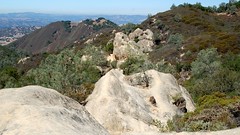 Many visitors to Mount Diablo head straight for the summit to enjoy the famous view. Summer days are sometimes hazy, and the best viewing is often on the day after a winter storm. Then, you can look to the west, beyond the Golden Gate Bridge, to the Farallon Islands; southeast to the James Lick Observatory on Mount Hamilton at 4,213 feet elevation; south to Mount Loma Prieta in the Santa Cruz Mountains at 3,791 feet elevation, north to Mount Saint Helena in the Coast Range at 4,344 feet elevation, and still farther north to Mount Lassen in the Cascades at 10,466 feet. North and east of Mount Diablo the San Joaquin and Sacramento Rivers converge to form the twisting waterways of the Delta. To the east beyond Califomia's great central valley, the crest of the Sierra Nevada seems to float in space.
Many visitors to Mount Diablo head straight for the summit to enjoy the famous view. Summer days are sometimes hazy, and the best viewing is often on the day after a winter storm. Then, you can look to the west, beyond the Golden Gate Bridge, to the Farallon Islands; southeast to the James Lick Observatory on Mount Hamilton at 4,213 feet elevation; south to Mount Loma Prieta in the Santa Cruz Mountains at 3,791 feet elevation, north to Mount Saint Helena in the Coast Range at 4,344 feet elevation, and still farther north to Mount Lassen in the Cascades at 10,466 feet. North and east of Mount Diablo the San Joaquin and Sacramento Rivers converge to form the twisting waterways of the Delta. To the east beyond Califomia's great central valley, the crest of the Sierra Nevada seems to float in space.


